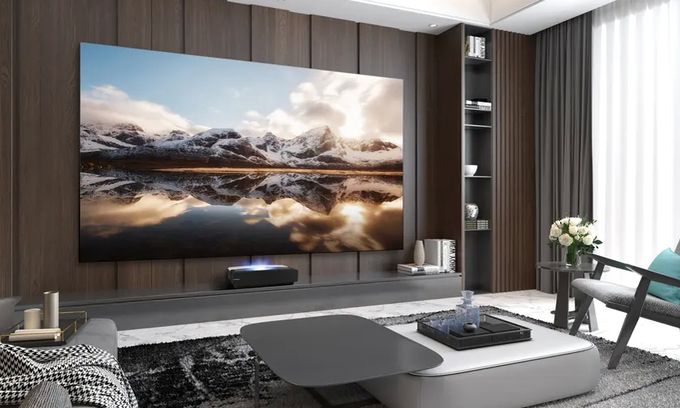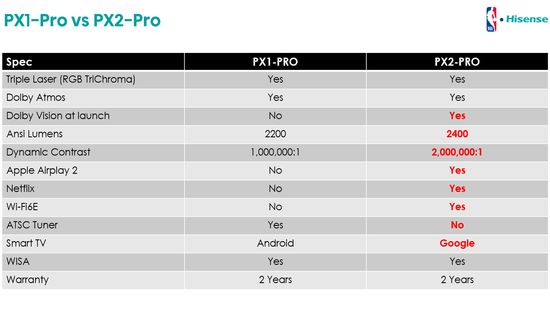UST 4K projectors are one of the most dynamic segments of consumer electronics, which is due to several objective reasons. Firstly, the built-in TV receiver, streaming and screen mirroring technologies have practically eliminated the content problem for projectors. Secondly, replacing lamps with solid state light (SSL) sources opened the way to reducing their dimensions and noise level. Indeed, the lamps are reliable, inexpensive and bright, but their strong heating requires a powerful, noisy fan and a sufficiently large internal volume to effectively dissipate heat. SSL-based light engines use LEDs or laser LEDs (LEDs with an optical resonator), which practically do not heat up during operation.
Until recently, LED projectors were not bright enough for premium levels. But, the new 4LED-design with an additional ‘pump’-LED (for example, in BenQ X3000i), or the use of industrial LEDs allowed developers to significantly increase their brightness. Laser LEDs are more powerful due to coherent radiation and provide brightness of 2,000 ANSI Lumens and above, which is enough to produce rich colors for 4K 100″-130″ images even in diffuse daylight. However, the list of factors for the rapid growth of their popularity is wider.
Resolution and UST design
Pixel shift-based TI’s XPR technology has significantly reduced prices for 4K projectors. It provides playback of 4K content using a relatively inexpensive DMD (Digital Micromirror Device) with native 1080p resolution (~ 2 million micromirrors). In fact, the projector divides 8 million pixels of 4K-image into 4 parts of 2 million. Then, the 4 XPR module electromagnets change the lens tilt 2 or 4 times per cycle (2-phase or 4-phase pixel shift), shifting the four 1080p images by half a pixel diagonally relative to each other.
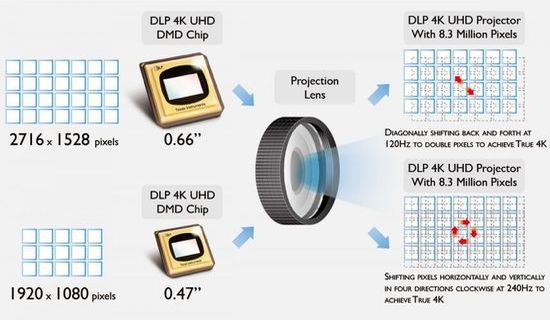
Of course, 2 million micromirrors produce only one a 1080p image at any given time. But due to the high frequency, the eye and brain perceive them as one higher-resolution image.
UST (ultra short throw) projectors have become the latest powerful argument for projectors as an alternative to traditional TVs. As known, traditional mid-focal projectors usually produce a 100″ or more picture from a distance of several meters. But this requires placing them in the room center, creating the problem of wires on the floor. In fact, today it’s solved only with a complex ceiling mount. UST models form a large image from a short distance.
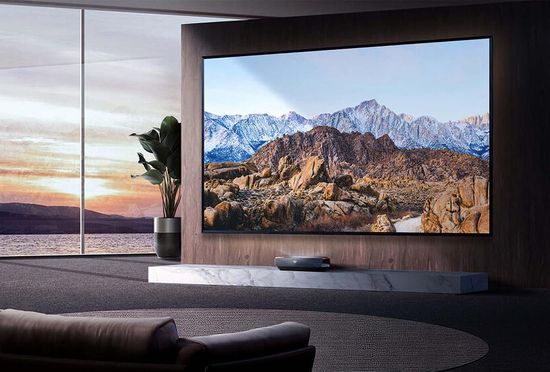
As a result, consumers are increasingly choosing UST 4K laser projector as an alternative to traditional TVs.
But they are still inferior in image quality due to lower contrast and brightness. Indeed, only expensive LCoS projectors provide contrast comparable to TVs. In addition, when watching TV, the viewer perceives a direct light flux from its screen, which is much brighter vs re-reflected projector light. As a result, even premium projectors provide a few hundred nits of brightness. By comparison, most modern budget TVs provide over 400 nits (cd/m²). However, assessing the brightness of modern projectors has nuances.
Projector brightness
Given the large impact of projector brightness on image quality, some companies traditionally use the light output value for marketing purposes. As a result, the industry has created several methodologies for its assessment, which ultimately provoked a little chaos. Perhaps it can be considered the cost of the free market. However, even a simplified classification can reduce this problem.
This list includes:
– ANSI Lumens (American National Standards Institute) – measures illumination at 9 points on the screen. The standard includes ANSI IT7.215 (1992) and IT7.228 (1997) editions. Based on a similar methodology, the International Electrotechnical Commission (IEC) developed IEC 61947-1 (2002) and 62906-5-1 (2021). In addition, the International Organization for Standardization (ISO) introduced ISO 21118 and its new 2021 version in 2005. These standards use ANSI or ISO Lumens units of measurement and are the most popular in the industry. For reference, 1 ANSI Lumen ~ 0.8 ISO Lumens;
– some manufacturers of projectors with LED light engines offer to take into account the Helmholtz-Kohlrausch effect (perception of color brightness) and use LED Lumens (1,000 LED Lumens ~ 417 ANSI Lumens).
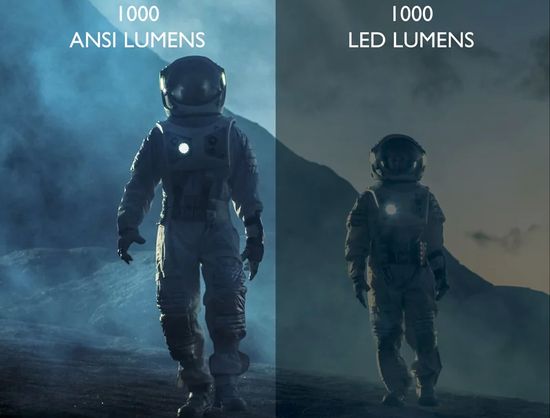
– Epson specifies Color Light Output (CLO), which is always identical to white brightness. As known, their 3LCD models work without a color wheel as a filter, which blocks 2 colors at any time, reducing the overall color brightness.
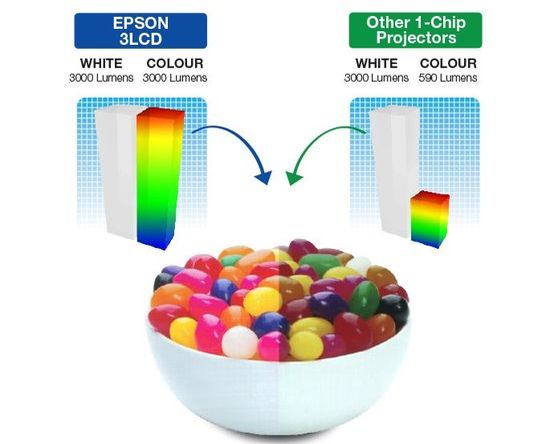
– Lux (illumination of one square meter of the screen).
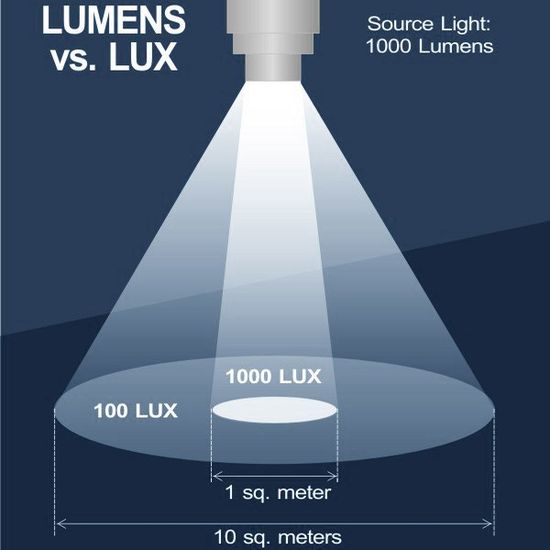
– CVIA Lumen.
In October 2022 the China Electronics Video Industry Association (CVIA) introduced a group standard developed by Hisense, JmGO, Dangbei, Harqu, etc. The conversion ratio has not yet been formed. But JmGO specifies the brightness of the newest N1 Ultra as 4,000 ANSI Lumens or 2200 CVIA Lumens.
Hisense UST projectors
Today the competition between TVs and projectors is in a phase of unstable equilibrium. The price of UST 4K laser projectors varies in the range of $ 2,000 – $ 4,000. They offer a huge picture from 100″ to 150″ with slightly lower quality vs flagship 65″-75″ TVs.
Due to wild marketing success, some companies, including Hisense and JMGO, have even started calling their models ‘laser TV’ or ‘laser cinema’. Perhaps these names will cause some physicists to smile ironically. Formally, any projector with a built-in TV receiver can be positioned as a TV with a screen outside the housing. But most industry leaders, including Epson, ViewSonic, Optoma, BenQ, etc still prefer the traditional name ‘UST projector’.
The Chinese giant Hisense clearly claims leadership in this segment. The first LG PF1000U UST projector was introduced in 2015. Its 1,000 ANSI Lumens brightness and 1080p resolution were hardly adequate for the price, which exceeded $ 1,000. A few years ago, Hisense introduced the L5F and L9G with a more competitive price-performance ratio. Perhaps they can be positioned as the pioneers of the epochal competitive battle between TVs and UST projectors.
Today, the Hisense UST projector lineup includes several series, among which PX Pro is one of the most popular. It includes the ultra popular PX1 Pro (January 2022), new PX2 Pro, and the recently announced PX3 Pro (will be available in 2024). In last summer company also introduced a cheaper PX1 version. It’s slightly less bright (2,000 ANSI Lumen), but significantly cheaper (~ $ 1,800).
Models in this ‘Laser Cinema’ series are supplied without a TV tuner, which reduces their positioning as a direct alternative to TV. They provide 90-130-inch screen size with Throw Distance of (0.5 m – 0.7 m) at 0.25:1 Throw Ratio.
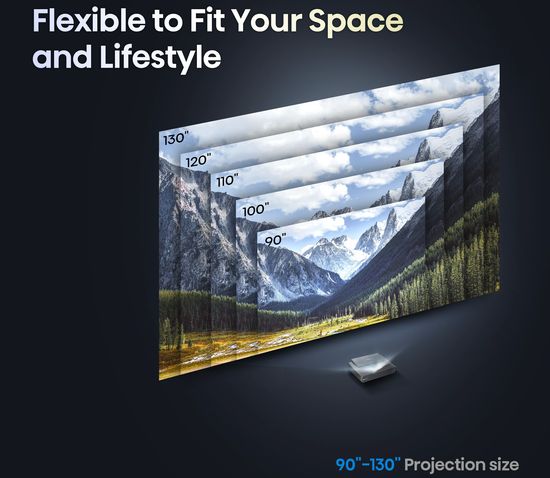
Hisense PX Pro series
All models use ALDP 4.0-based (Advanced Laser Phosphor Display) triple color laser light engine, which provides an unprecedented 107% BT.2020 color gamut.
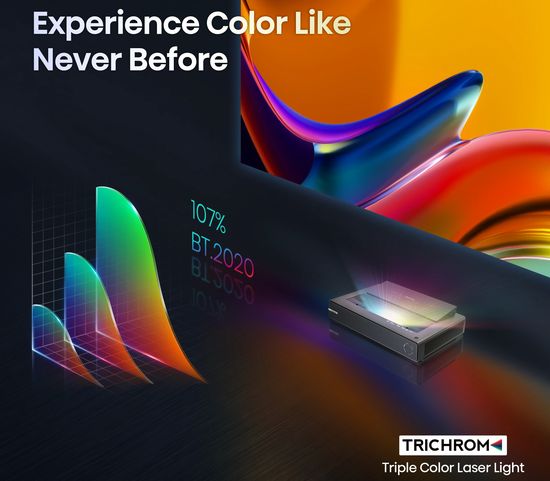
Of course, ultra-wide color gamut has significantly improved their image quality, but, unfortunately, RGB design has a drawback. Interference of laser beams due to non-ideal surfaces and microparticles creates speckles on the image, which look like a high-grain photo. Of course, companies are struggling with this problem. For example, last year’s Xiaomi Formovie Theater significantly reduced the speckles with a hybrid ALPD 4.0 RGB+ light engine, which combines RGB lasers and phosphor.
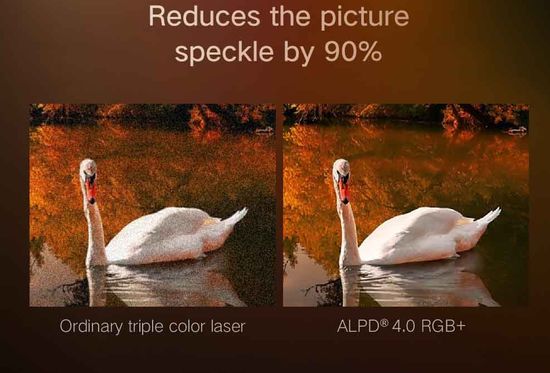
But objectively this problem exists.
All models support Filmmaker Mode, Amazon Alexa and Google Assistant, have Game Mode with ALLM (Auto Low Latency Mode), Digital Lens Focus, Geometric Correction and MEMC (Motion Estimation and Motion Compensation). In fact, this is a frame interpolation for smooth playback.
Unfortunately, they do not support 3D and dynamic tone mapping.
The PX1 is the least bright and provides 2,200 ANSI Lumens (ANSI IT7.228 standard). The brightness of the PX 2 and 3 reaches 2,400 ANSI Lumens, which is enough for rich 100-inch images even in diffuse daylight.
Despite the identical price of ~$ 3,000, the PX 1 and 2 Pro models are quite different.
Increased dynamic contrast (2,000,000:1 vs 1,000,000:1) is due to better black levels. In addition, PX2 has built-in Netflix with Google TV and 2x HDMI 2.1.
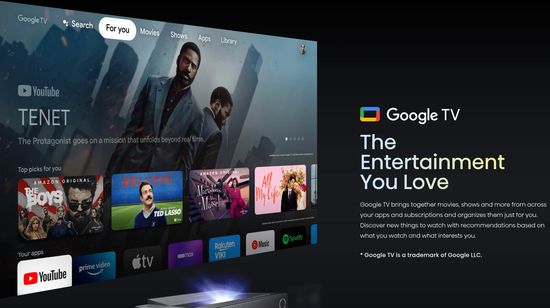
Both models use reduced blue light emissions, are compatible with HDR10 / HLG formats and have built-in 30W Dolby Atmos sound. Their input lag is ~ 38 ms.
In addition, PX2 Pro uses the new 4-core MediaTek MT9900 with high performance, which supports dynamic metadata of Dolby Vision and HDR 10+.
Hisense PX3 Pro
Information about the new model is still very limited. Hisense PX3 Pro was presented at IFA (Internationale Funkausstellung Berlin) 2023.
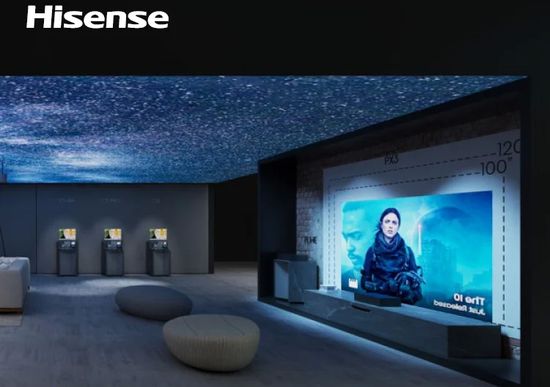
Like PX2, it supports HDR10 / HDR Dolby Vision and decodes dynamic metadata of an HDR10+ signal. According to the company, PX3 covers 110% of the BT.2020.
Hisense PX3 Pro runs Vidaa U6 or U7 version, providing access to AirPlay 2/Apple Home and to Internet streaming (Disney+, myCanal, Netflix, Prime Video, Salto, Rakuten TV, Youtube, etc).
Like the PX2, it offers 2,400 ANSI Lumens brightness and a 90-130-inch screen size with Digital Lens Focus.
But the new projector uses an optical system with a Throw Ratio of 0.21:1. Accordingly, reducing the Throw Ratio from 0.25:1 to 0.21:1 reduces the minimum required distance between the projector and the screen to 35 cm. To be honest, the minimum required 50-70cm between wall and back wall in PX1 and PX2 is also not a problem. However, the general trend towards reducing the distance is relevant for UST models. But the record among UST projectors is still 0.19:1 Throw Ratio. Given the projector depth, in this case its front panel practically touches the screen.
The model has HDMI 2.1 with eARC (lossless digital audio transmission) and ALLM support.
Unfortunately, the projector only supports 4K@60Hz, limiting the capabilities of the new PS5 and/or Xbox Series X.
Unlike its predecessors, PX3 offers a more powerful 40W (2 x 20W) audio system with Dolby Atmos support.
Dinamic contrast ratio is not yet known, but the announced native contrast ratio is 3,000:1, which is superb for DLP projectors.
Tentatively, PX3 Pro will be available in mid-2024 with a launch price of € 3,400.
Conclusion
This year, the Chinese giant has consolidated its position among the leaders in the UST laser 4K Home Theater projectors segment. Hisense PX2 Pro has become a worthy replacement for the ultra popular PX1 Pro. According to the company, in 2024 it will pass the baton to the announced PX3 Pro. The new Hisense PL1 also gained almost instant popularity in the consumer market. Both models claim to take a place among this year’s bestsellers.
But, of course, competitors are also not wasting time. A partial list of new UST models for 2023 includes:
–BenQ V5000i – $ 3,500;
–Visionair-e Platinum Vision 3000 – $ 3,750;
–Epson EB-810E – $ 3,300;
– CHiQ B8U and B7U – $ 3,000 and up to $ 2,000;
–Hisense PL1 – $ 2,500.
However, taking into account the prices, specs and functionality, Hisense offers superb price-quality ratio, which promises cloudless marketing prospects for its models.
But UST projector manufacturers may not be in for a very pleasant surprise. Adequately responding to the growing popularity of competitors, some TVs manufacturers are increasingly focusing their efforts in the segment of huge models. This strategy is already producing results. The lines of the Chinese and South Korean giants already include 100-inches TCL 98S550G, 98X955/98QM850G and Samsung 98Q80C. Moreover, companies managed to significantly reduce their prices. In particular, the new ‘budget’ TCL 98S550G costs only $ 3,700 – $ 4,000, last year’s 98R754 – up to $ 5,000. The price of premium 98X955 / 98QM850G and Samsung 98Q80C reaches € 8,000 / $ 7,000 and $ 6,500, respectively.
This video shows Hisense PX2 Pro.
